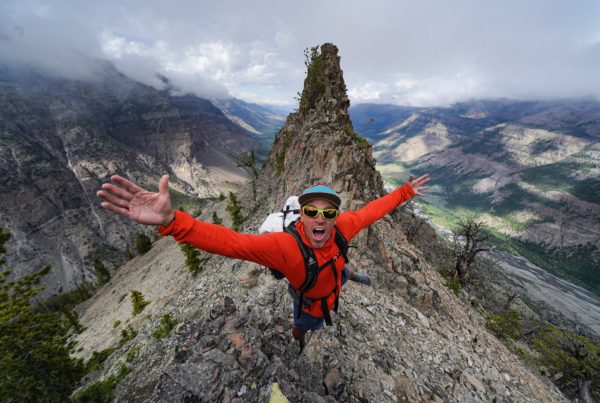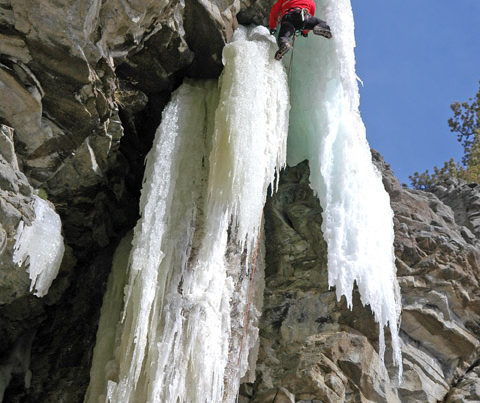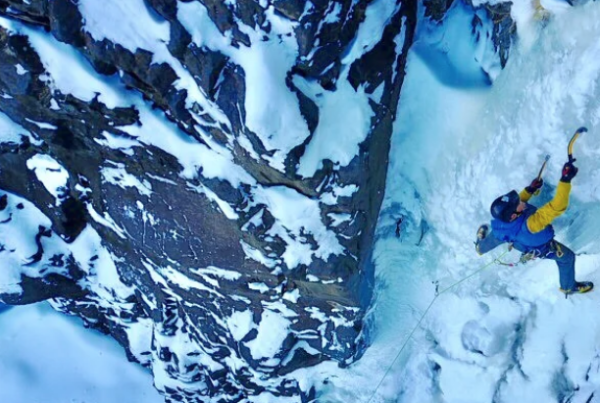My usual blog posts are to celebrate an achievement or a great adventure and when I started writing this post I didn’t want to do it, but I realized as each word fell into place it still was a celebration. Keith Spencers life and his achievements should be celebrated and I think you will find that some of us can only hope to achieve half of what he conquered.
Keith Spencer, 45, was a world-class mountaineer, having soloed Denali, Aconcagua and most recently, Cho Oyu. Known for his taciturnity, Keith could make a Clint Eastwood character sound like a blabbermouth. When he spoke, it was usually with wry wit and a twinkle in his eye. He was in the Air National Guard, and competed as a biathlete for them for many years. Besides mountaineering, Keith was an outstanding runner, placing in local races and nailing a 3-hour marathon. He was also one of the first people to backpack the length of the Continental Divide, from Mexico to Canada, as well as a member of the first team to mountain bike the length of the Great Divide in Australia. Keith was one-of-a-kind and will be deeply missed by his family of outdoor adventurers.
People have been asking all week how did it happen and why? I believe getting hit by an avalanche of this size and in the South Fork Valley is along the odds of getting hit by lighting. Nobody knows why it happen or how it happened it just happened. I think as a society we search for answers a reason or someone to blame. In this instance we have none of those things but to know that Keith died doing what he loves. There were no mistakes, no bad judgments they were as safe as they could possibly make themselves in the environment they love.
Search and rescue plane flying above as we headed in to the climb. (look at the clouds closely?)
Written By Mark Jenkins,
To begin, Keith and I drove up to Cody on Thursday, New Year’s Day. Having recently soloed Cho Oyu, the world’s sixth highest peak, Keith was practically voluble. He talked more in that seven-hour drive than I’d heard him say in the last decade. He was proud and pleased with his approach and performance on Cho Oyu. He’d made close friends on the climb and they were already planning an expedition to Lhotse in two years time.
We spent the night in Kenny Gasch’s Spike Camp in downtown Cody, rose at five, were scouting falls in the South Fork by seven. After glassing a half dozen falls on both north and south slopes, we decided on the Main Vein, a WI-IV, 5-pitch route on the north side near the end of the valley. It was snowing and blustery, usual Wyoming winter conditions. We could see the top headwall double-pitch (220 feet), but little above that because of the inclement weather. We chose this route for several reasons: 1) it looked fat and thus safe, 2) the first pitch, which rarely forms, was in, 3) Keith had never climbed this route before, this would be my fourth ascent, 4) the grade was moderate.

It had snowed almost 6 inches over night after the accident but it was still very easy to see the amount of snow and debris that fell into the climb in some spots over 10 feet deep.
I led the ice pitches, Keith led the snow pitches. Partway up the second ice pitch we were hit by a spindrift avalanche, and both blasted with snow dust. This is common in the South Fork. As far as I know, no one has ever died or even been hurt from an avalanche in the South Fork. It is a dry region and avalanches were not previously consider a threat.
At the base of the 3rd ice pitch, we found avalanche debris, which surprised us. I suggested that this was a good sign, because it meant that anything loose above us had now slid. Keith didn’t respond, but this was typical Keith, as most of you know. Focused on the climbing, he probably hadn’t spoken five sentences that day.

Note the crown of the avalanche
At the base of the headwall—the 4th and 5th pitches—although it was still snowing and blowing, the icefall and the rock walls around us were clear of snow and there was no evidence of a fresh avalanche, which we took as a good sign. I set off on the 4th pitch at 1pm, climbed 115’ and put in a belay, deeply placing two long screws and stomping out a small platform for my feet. I placed the belay in a tiny alcove of ice, below a vertical bulge, so that Keith might be protected from any falling ice when I led the last pitch.
Keith seconded methodically, as was Keith’s way. He was in high spirits. Cresting the last vertical bulge, he was 15’ below me, when he shouted “avalanche” in a nonchalant voice. I’m sure he expected it to simply be another slough. A millisecond later a horrific roar began. It was such a hideous, unimaginable thunder, I can only compare it to placing your head against a railroad track as a freight train blasts by.

Heading up the Avalanche debris
I instinctively squeezed flat against the ice. The bombardment went on and on and I fully expected to be torn from the ice. I was screaming from terror. I cannot say how long the avalanche lasted—30 seconds, a minute, two minutes. When it finally ended, I was still there and Keith was gone. The power of the avalanche had pulled the entire icy rope through the belay device. Keith had fallen 200 feet. I found him hanging at the end of the rope. He was not breathing and had no pulse and it was clear his neck had been broken.

This is the main fracture line which goes beyond the photo on both sides. It truly shows the magnitude of the avalanche.
The next day Keith’s body was recovered and a search and rescue plane flew by to take photographs of the Main Vein drainage. The avalanche had started when a cornice at the crest of the mountain, 1500 feet above Keith and I, broke. The crown face of the avalanche was 5-10 feet deep and extended a quarter mile along the mountain top. Thousands of tons of snow funneled through a 30-wide passage.
There is no reason this massive avalanche slid at this moment. It could have slid that night, or two days earlier or two days later. Keith and I had no knowledge of this cornice, but I later learned that high winds and very cold temperatures had created a dramatically unstable snowpack.
I don’t know why the ice screws held. There is no reason I am alive and Keith is dead.
Keith was a man of extraordinary honor, humility and discipline. I will miss him terribly, as will we all
Go to Summitclimb.com for photos, adventures and the lifes Keith has touched.







